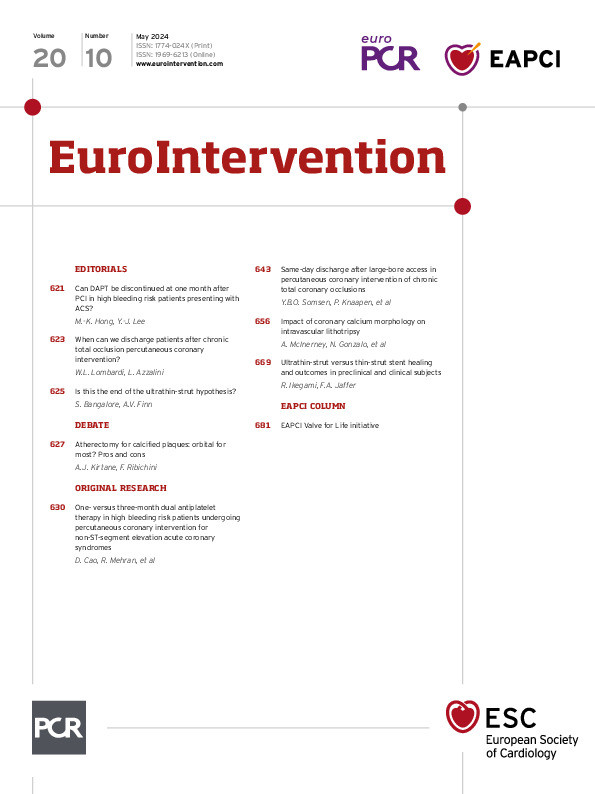For patients with acute coronary syndrome (ACS) undergoing percutaneous coronary intervention (PCI), dual antiplatelet therapy (DAPT) with aspirin and a P2Y12 inhibitor is required for preventing ischaemic events, and 12 months of DAPT is currently the standard treatment12. However, maintaining DAPT long term may be associated with an increased risk of bleeding, and therefore, the strategy of shortening the duration of DAPT has been investigated3. Attaining optimal protection against ischaemic events while avoiding an increase in bleeding-related harm is crucial, especially in patients with high bleeding risk (HBR)3. The MASTER DAPT trial randomised HBR patients undergoing PCI and compared 1-month DAPT with ≥3-month DAPT4. In accordance with the main trial results, its prespecified, stratified subgroup analysis focusing on patients with an acute or recent myocardial infarction demonstrated that while the risk of cardiovascular events did not differ between the two groups, 1-month DAPT was associated with a reduced risk for Bleeding Academic Research Consortium (BARC) type 2-5 bleeding5. However, only biodegradable-polymer sirolimus-eluting stents were used, and approximately 75% of patients in the 1-month DAPT group received P2Y12 inhibitor monotherapy as a single antiplatelet therapy regimen after DAPT5. Therefore, more evidence with different stent types and an alternative single antiplatelet therapy regimen (i.e., aspirin) have been required to support the feasibility of a 1-month DAPT strategy in HBR patients presenting with ACS.
In this issue of EuroIntervention, Cao et al sought to compare the impact of 1-month DAPT versus 3-month DAPT on 1-year ischaemic and bleeding events in HBR patients undergoing PCI for non-ST-segment elevation ACS, based on data from the XIENCE Short DAPT programme6. The XIENCE Short DAPT programme consisted of three prospective, multicentre registries conducted in North America, Europe, and Asia, which represent real-world registries involving various races6. This study included 1,164 HBR patients undergoing PCI for non-ST-segment elevation ACS6. While the risk of the primary endpoint of death or myocardial infarction was not different between the 1-month DAPT and 3-month DAPT groups, the key secondary endpoint of BARC type 2-5 bleeding was significantly lower in the 1-month DAPT group6. In contrast with the MASTER DAPT trial, in this study, biocompatible-polymer everolimus-eluting stents were used, and all patients received aspirin as a single antiplatelet therapy regimen after DAPT6. The results of this study further support the feasibility of a 1-month DAPT strategy in HBR patients presenting with ACS, regardless of stent type or single antiplatelet therapy regimen after DAPT. Although these results are outstanding, there are some important aspects to consider while interpreting them. First, this study was not randomised. For instance, radial access was more commonly used in the 1-month DAPT group, which may have contributed to the difference in bleeding events. Second, patients with complex coronary lesions or ST-segment elevation myocardial infarction were excluded. Third, the risk of major bleeding (BARC type 3-5) was not different between the two groups, which may imply that the difference in the bleeding events could be attributed to BARC type 2 bleeding. Moreover, when patients on oral anticoagulation were excluded, BARC type 2-5 bleeding did not differ between the two groups. Lastly, the definitions for HBR were not identical to those proposed by the Academic Research Consortium consensus7.
To conclude, Cao et al provided important, essential evidence to further support the feasibility of a shortened DAPT − of 1 month – in HBR patients undergoing PCI for ACS and should be complimented for their outstanding study which may motivate the implementation of further randomised trials regarding the optimal antiplatelet therapy, especially in ACS patients at high bleeding risk. Future studies should acknowledge that modulation of an antiplatelet therapy includes not only shortening DAPT but also dose reduction and the switching of antiplatelet therapy regimens3. They should also take into account consensus recommendations aimed at proposing guidance for clinical trial designs for patients at HBR undergoing PCI7. Recently, the results from the ULTIMATE-DAPT Trial, which evaluated the efficacy and safety of a ticagrelor-based 1-month DAPT strategy in patients with ACS, have been reported8. Furthermore, there is great anticipation for its subsequent substudy, which will focus on high bleeding risk.
Conflict of interest statement
M. Hong has received speaker fees from Medtronic and Edwards Lifesciences. Y. Lee has no conflicts of interest to declare.

